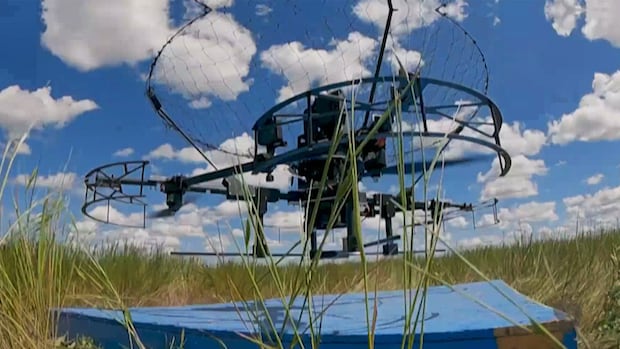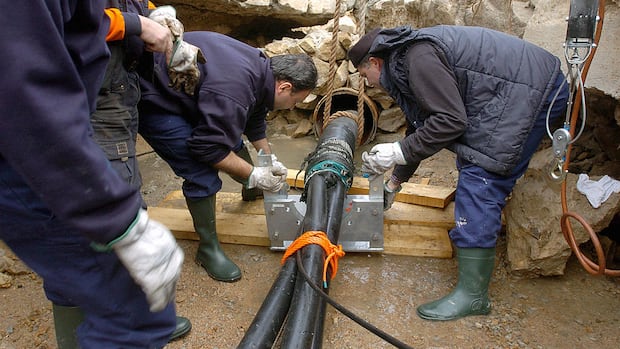An old-fashioned game of cat and mouse has quietly unfolded for almost a year in parts of the North Atlantic, the North Sea and the Baltic Sea between NATO allies and a Russian surveillance ship.
It is a contest that has European political and military leaders increasingly concerned.
Separately, but in tandem, there have been multiple incidents of subsurface cables being damaged over the last two years, mostly in the Baltic region, but also in July in an incident off Orkney and Banff in the U.K.
Whether they represent deliberate attacks or accidents is a matter of investigation.
There is, however, a growing consensus that more needs to be done to protect the undersea infrastructure, which is the lifeblood of the global economy.
To that end, last week, Germany’s armament secretary and the head of the country’s navy were in Ottawa to meet Canadian navy and defence officials and discuss their plans to introduce maritime drones — both surface and subsurface.
“It turns out that this is another area of potential co-operation with great potential,” Jens Plötner, the armament secretary, told CBC News.
Remotely piloted underwater vehicles are seen as crucial in protecting the subsurface infrastructure, but how to do it and who is responsible is a matter of active debate.
The Yantar, a Russian research ship that Western intelligence believes is mapping the spiderweb of undersea cables and infrastructure, keeps popping up — sometimes unexpectedly — in several locations.
The ship’s habit of loitering near undersea cables — particularly in November and December 2024 — caught the attention of Finnish and Swedish authorities.
WATCH | Canadian drone-builders looking to Ukraine: :
Canada applies lessons from Ukraine in a new arms race for drones
Canada’s government and military are trying to get a Canadian edge in a new arms race for drones by issuing industry challenges, and testing everything from marine drones that can attack ships to lasers that can burn drones in mid-air.
Peter Sandwell, Sweden’s state secretary of defence, was also in Ottawa late last week meeting with Canadian defence officials.
He said his country, which is NATO’s newest member, has been tracking potential threats in the Baltic Sea.
“I think we’ve all learned the importance of making sure that critical infrastructure on and below the surface are as secure as possible,” Sandwell told CBC News in a recent interview.
“We’ve had a number of incidents in the Baltic Sea where there have been shortcomings, intentional or not, that has caused concern. And we are looking at all sorts of means to make sure that we can maintain the safety of critical underwater infrastructure.”
In response to the rising number of incidents, NATO last January launched a mission named Baltic Sentry to increase its military presence and monitor threats to underwater infrastructure. That surveillance mission was enhanced last month with the presence of a U.S. warship, the guided missile destroyer USS Bulkeley.
Drone technology advances
The European Commissioner for Defence and Space, Andrius Kubilius, said the war in Ukraine has been an important catalyst for advances in drone technology.
Speaking last weekend on CBC’s Rosemary Barton Live, Kubilius said the West is behind both Ukraine and Russia in their development and use of remote technology.
“We need to catch up,” he told host Rosemary Barton, “but what we need, also, to see is that Russia really is turning all their economy to so-called war economy.”
The Royal Canadian Navy is in the process of acquiring autonomous subsurface drones, which are designed to seek out and destroy underwater mines.
A handful of Canadian companies are at the cutting edge of marine drone technology. For example Seamor Marine Ltd. produces drones used for aquaculture, underwater inspection of infrastructure and general underwater exploration.
Plötner said Germany is not building its own drones but “wants to get there.”
He was concerned, however, about the intersection of defence and the private sector when it comes to the protection of undersea cables and critical infrastructure.
Plötner doesn’t think governments should carry the burden alone.
“I do not think that it is the job of your government nor of mine to take care of every internet cable or pipeline down there,” said Plötner.
“It’s certainly also the responsibility of the companies we’re talking about. Can they do it alone? No, but they should significantly contribute and this needs to lead to a much, much closer co-operation, civilian and military.”
Just last month, the U.K. Parliament’s joint committee on national security strategy released a report that noted corporations in that country are unconvinced that there’s a major risk.
“We also found skeptical views in some parts of the cable industry about the risks of co-ordinated attacks,” said the report.
“We agree that resilience across the sector is generally robust, major disruption is unlikely and hype is unhelpful. But we caution against adopting ‘business as usual’ industry views to determine national security risk: individual operators have few financial incentives to prepare for a crisis that may never come. The government, by contrast, has a duty to prepare competently for low-likelihood, high-risk scenarios.”
